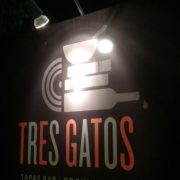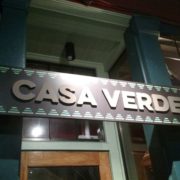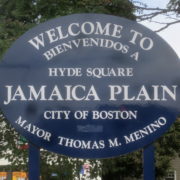Boston, MA Restaurant Group ‘Hospitality Admin Fee’ Successfully Narrowing FOH/BOH Wage Gap: 1-Year Update
By: Patrick Maguire
Book Chapter: Human-to-Human Service
Posted: 12/1/2016
Full Disclosure: Tres Gatos, Centre Street Cafe, and Casa Verde restaurants in Boston are clients of my PR, Social Media & Hospitality Consulting business.
As is often the case, they endured vitriolic comments from online trolling dissenters. Similar to the way some Yelpers ‘review’ restaurants without visiting or dining in them, some folks are more interested in denouncing creative solutions than making an honest effort to study and understand them.
When an ownership group of 3 Boston restaurants introduced an innovative idea to combat a very complex problem, they were called greedy, sanctimonious and insincere, and told that “they must have lost their minds. The greed of these guys is pathetically transparent and offensive.” They were accused of “cloaking their business decision in this mantle of righteousness,” promised boycotts, and their innovative Hospitality Administrative Fee (HAF) has been called a “gimmick,” “yuppie tax” and “socialist bullshit.” Several other thoughtful, engaged commenters applauded their enterprising initiative.
They engaged many of the online commenters in great detail with respect, restraint, facts, and a promise to report their findings.
Co-owner, Keith Harmon responding to Facebook commenters, “I understand the resentment. We tried many, many other approaches. This is an idea that generates a lot of internet hate but in practice people who come into the restaurant are very supportive. It’s the toughest issue facing restaurants today, which is why you see so many places experimenting with solutions. If there is an effective solution that has zero visibility to the guest than we will absolutely change our policy.”
“We’re going to work our tails off to see it successfully implemented, but it’s definitely a big risk and we’re hoping we can get enough support for the new business model to make it effective and sustainable.” –Keith Harmon Eater Boston 12/1/15
Megan Woolhouse in the Boston Globe on 3/5/16 called the Hospitality Administrative Fee, “…a risky strategy in a competitive industry fearful of alienating customers, but it also may be the way of the future.”
Keith Harmon, David Doyle, and Maricely Perez-Alers, co-owners of Tres Gatos, Centre Street Cafe, and Casa Verde restaurants in Jamaica Plain, MA were well aware that changing their business model was a risk when they pioneered the bold, progressive measure of adding a (pre-tax) 3% Hospitality Administrative Fee (HAF) to guest’s checks on 12/1/15 in order to pay their back of house (BOH) kitchen staff higher wages, closer to what their front of house (FOH) servers and bartenders were making.
In a Boston Magazine piece titled, The Great Cooks Shortage, Corby Kummer stated, “If other owners don’t rip off the Band-Aid and eliminate tipping to pay kitchen workers more, or adopt Harmon’s sensible plan, anyone who cares about restaurants and the culture of the city will be forced to say that Boston is in dire straits.”
In their “Open Letter to the Restaurant Community,” on the websites and on an entire side of the menus at their restaurants, the trio stated, “We acknowledge that this is a risk, one that might not work, and if it doesn’t we’re willing to chart another course.”
I vividly remember the restaurant environment when the HAF was being implemented. It absolutely was a risk, but in retrospect, a very carefully calculated risk. Before implementation, research and considerations included:
- ‘Traditional’ restaurant business models, equations, percentages, and formulas for opening, operating, and sustaining restaurants were not working, and immediate, corrective action was required to survive and sustain. The existing model was breaking under price pressures and the FOH/BOH wage gap.
- Operational costs had steadily increased while profit margins had been allowed to decrease in order to increase BOH compensation.
- The belief that restaurateurs need to adjust expectations and implement new models for current and future independent operators.
- The time, effort, energy, and cost required to implement, explain, and defend a ‘non-traditional’ business model. (Including additional accounting/bookkeeping hours to track and fairly distribute new fees and pay taxes on those fees.)
- Flat pay with profit sharing.
- Creating a culture of mutual respect and trust where employees feel valued, safe, and compensated fairly. Individual and team morale and quality of life are extremely important.
- Inspiration from Zingerman’s inclusive, progressive business model and philosophies.
- Staff retention and recruitment. Minimizing the time, effort, energy, and cost of hiring and training new employees was a very important goal.
- Eradicating ‘traditional’ resentment and tension between FOH and BOH over compensation. HAF allows FOH and BOH to rise and ‘fall’ in unison.
- The potential impact of using mega-vendor food suppliers to drive down expenses would compromise quality and was inconsistent with their mission statement of directly supporting small, local, suppliers and agriculture.
- Cutting costs by reducing support to local charities, non-profits, and neighborhood community organizations that are critical to the mission of the restaurants was not an option.
- “Customer accepted” menu price points vs. “non-traditional” approach, requiring explanation and education of diners in the restaurant and prospective guests researching their restaurants online.
- A solution that didn’t include eliminating tipping and alienating/losing quality servers and bartenders. They also didn’t want to take the discretion and control of tipping away from guests and did not believe that guests or the industry were ready to let go of tipping. Tipping was too widely embraced by their servers and guests.
- A “No Tipping” policy is extremely difficult to transition to as an established restaurant. (They respected Juliet and Tasting Counter for implementing a “No Tipping” policy as new restaurants.)
- BOH staff was being paid at competitive, “industry standard” rates or above, but the owners felt that was unacceptable, especially for entry-level cooks. They also wanted to allow for a more sustainable schedule and a reasonable number of total hours worked weekly for BOH staff.
- The desire to create a competitive advantage to address the BOH staffing shortage in Boston area restaurants, and create a model to make small, independent restaurants more sustainable.
- Raising BOH wages without hospitality admin fee. This would reduce mid-single digit profit margins further, putting the viability of the restaurant at risk of surviving, especially a catastrophic event (‘temporary’ closure of business due to weather, equipment failure, an accident, flooding, building damage, etc.) Restaurants are often one significant event away from closing for good, and then everyone loses. Doing nothing was not an option.
- The common perception that restaurants are highly profitable, and “wealthy owners” should simply reduce their own compensation to pay BOH staff more. (Harmon and Doyle explained to online commenters that this perception was incorrect, and that repaying loans to investors, meeting payroll, and other priorities always take precedence over owner compensation, and have.)
- Pending legislation regarding salary minimums, OT, sick days, benefits, etc. (Minimum wage increases were not a concern unless the tipped minimum wage increased substantially.)
- Forecasts/estimates for inflation, costs of all goods and services, insurance, etc.
- Public perception of change and trying something “unconventional.” Not everyone will take the time to read or try to understand what’s happening and why. Some people just won’t like it, no matter what.
- Legal, accounting, and all local and national Government rules and regulations. (Massachusetts law makes it illegal for BOH staff to be included in restaurant tip pools.)
- The requirement to operate a business they were proud of rather than stagnate.
Keith Harmon-Personal Facebook post 12/2/15: Well, here we go – For most of the past 5 years I have been working on the problem of back of house (read kitchen) vs. front of house (read servers and bartenders) wage gaps. For the past several years, I have had an ongoing dialogue with my business partners as to how we could potentially close the gap and have been developing an approach. With Danny Meyer’s announcement in regards to the same issue in his restaurants, and numerous other factors, we decided early last month to put the finishing touches on our best solution and implement. It’s a big risk, but I’m super excited and motivated to share not only the vision, but the mechanics, the underlying data, and the results hard and soft as they come in. I love the restaurant Industry and am coming up on almost 30 years working in it. Parts of it won’t function properly for much longer, and this is a key piece. The “status quo” is headed “the way of the dodo” in the next 5-10 years, and I am so proud and excited to get started early on behalf of and side by side with our teams. Time to get busy living or get busy dying.
The strategy:
Implementation began on 12/1/15. The front, left side of the menus at Tres Gatos and Centre Street Cafe included the following messages in plain view:
Beginning December 1st, 2015, a flat 3% hospitality administrative fee will appear on your bill. This goes directly to our kitchen crew, in the form of increased wages and more sustainable hours.
Parties of 6 dining adults or more will see a 15% service charge and a 7% hospitality admin fee. All service charges and gratuities will go to your server; all hospitality admin fees go to the kitchen.
Please see the back of this menu or our website for more details. We thank you in advance for your support and look forward to answering any questions you may have as we endeavor to create a more fair and sustainable restaurant.
An Open Letter to the Restaurant Community: Why we are changing our business model, and why you will see an administrative fee on your bill.
We have decided to change the business model of Tres Gatos and Centre Street Cafe in Jamaica Plain in order to be able to pay our back of house (BOH) kitchen staff better in relation to the rest of our team. The disparity between front of house (FOH) and BOH compensation has been growing for many years. What was a gap 25 years ago has become an abyss, and it will only continue to widen. We think that within 5 years the majority of restaurants will have adopted some measure to address this critical issue. We are choosing to do so now for the benefit of our BOH teams, and because we would like to be agents of change and share our results with other restaurants. We are writing this letter for three reasons:
1. To be completely transparent to all of our stakeholders (team, community, guests, vendors, investors/lenders) about what we are doing.
2. To explain why we are doing it and why it is so important to us and our industry. And,
3. To ask for support as we try a new approach.
There are some well-known statistics regarding wage growth among tipped employees vs. non-tipped employees. In our restaurants, tipped/FOH team members make 2.2 to 2.6 times as much as non-tipped/BOH employees. The fundamental issue underlying this widening gap, as we have come to see it, is that tipped employees are tied to top-line revenue, whereas back of house employees are tied to bottom line results.
Every time we increase menu prices to cover inflation somewhere in the expense structure, we cover the expense but we widen the wage gap. While we’ve largely been spared the hiring crisis many restaurants have faced, we feel the wage problem can no longer be ignored. How can we as owners tolerate a scenario whereby half of our team’s compensation is about 60% lower than the other half’s? We’re tired of feeling like our kitchen staff are second class citizens. We’re tired of knowing that they would be financially better off bussing tables or working at a chain restaurant. We need to hitch (at least part of) their star to top line revenue if we want to correct the disparity.
The impasse we’ve reached presents us with a host of difficult choices. Do we live with the status quo and accept stagnant wages in the kitchen? Or, in an effort to pay our kitchen staff more, should we cut total hours and streamline how we operate: stop making our own pasta, bread, and pastry, and buy those things even though we know they’re better if we make them? Should we stop doing our own fish and animal butchery? Should we work with mega-vendors and stop supporting local agriculture? Should we give less to charity and support fewer local events and organizations? Or, finally, should we ask guests to pay more in order to directly benefit the kitchen?
Beginning December 1, 2015 we are making two substantial changes to how we charge at Tres Gatos and Centre Street Cafe: First, all group, prix fixe, and event dining will have a 15% service charge and a 7% hospitality administrative fee added to the bill. Second, all other diners will have a flat 3% hospitality administrative fee added to their bill, and guests may still tip as they see fit.
All of the charged hospitality administrative fees will be used for raises, benefits, and more sustainable work hours for our BOH team. We know many people will ask, “Why don’t you just raise your prices? This is your problem.” Our response is that it is our problem, and that in fact we are raising prices, albeit in a slightly different way that specifically aims to close the quality of life gap between front and back of house.
The FOH/BOH wage gap issue pervades the U.S. restaurant industry. Success and evolution in this industry is our life’s work, and we believe our restaurants – and small, independent restaurants in general – will not be sustainable for much longer without a correction. Quality restaurants cannot function, much less thrive, without quality chefs and cooks. We hope that making this small change will have a sufficiently large effect. Our goal is not only to improve the lives of our BOH employees, but to serve as a test model from which other small restaurants can gain valuable insight. We acknowledge that this is a risk, one that might not work, and if it doesn’t we’re willing to chart another course. But we need to take our best shot at fixing a problem that is growing increasingly difficult and intolerable, and we need your understanding and support.
For small restaurants that don’t want to sacrifice craft or integrity in order to serve the communities they love, we believe this is a fair, effective, and sustainable approach. We will open Casa Verde with this model as well. Our hope is that by making the compensation more equitable at each restaurant, our teams will be able to achieve more, not less, for many years to come. We thank you in advance for your understanding and support as we attempt to correct this core issue.
Thank you,
We Live to Serve,
Keith Harmon, David Doyle, Maricely Perez-Alers
Communication:
Successful implementation of the HAF required thoughtful, thorough communication, internal and external. The owners held a staff-wide meeting to explain the plan, solicit input, and to ensure that the entire team understood and supported the plan. Mutual trust and shared vision were crucial to the success of the plan.
As one of the first restaurant groups to implement this business model locally, and the first to communicate in such detail, many people were watching. Restaurateurs locally and nationally reached out, empathizing and offering support. The story was reported locally on WCVB TV, BNN News, Eater Boston, Jamaica Plain News, Boston Globe, Boston Magazine, Universal Hub, Boston.com, The HAF was also a very lively, engaging topic on Reddit and Hungry Onion.
As Keith and David mentioned on BNN News, it was important that they carefully communicated what they were doing and why. They were very proud of what they were doing and did not want to appear that they were hiding it in fine print in a “footnote on the menu.” If it was going to work, they felt they had to broadcast it far and wide.
As George Couros, author of The Innovator’s Mindset notes, “If you want to create “change,” you have to not only be able to articulate what that looks like, but show it to others.”(1)
Execution Details (How does it work?):
Keith Harmon: It’s a revenue sharing pool that is fed by the 3% administrative fees. We pay kitchen staff $1/hr extra in every paycheck, then we distribute any excess collected according to total hours worked at the close of each month. Since the money is distributed evenly by hours worked it’s more effective at the lower end of the payscale, which is part of the design. The HAF does not come from FOH tips, it is added to the pretax total of the bill and guest tips as they see fit on that total. So if you and a friend come in and order $100 in food, we charge a $3 admin fee that goes exclusively to the kitchen. We could have just raised prices, but that is a one-time fix. This is systemic. Now as total sales go up or prices rise in the future due to inflation, the servers and kitchen will each make more in lockstep. Adding the HAF to a guest’s check was the simplest, best solution we could find to a very complicated problem.
The Results:
#1-Early Returns, one month in:
Facebook Group Server Not Servant Keith Harmon January 19, 2016:
I am happy to report that the hospitality admin fees for December 2015, when distributed 100% and equally among the kitchen staff (only) according to hours worked, resulted in an average pay bump for kitchen staff of $2.29 per hour at Tres Gatos and Centre Street Cafe. We saw no negative impact on sales, tips for servers were actually slightly higher than usual, and we had about 6500 guests in December across the two restaurants WITHOUT A SINGLE COMPLAINT. The only impact on our bottom line was the resulting payroll FICA taxes we incurred due to the extra wages paid. Long way to go, this is a good start.
#2-One Year in, 11/30/2016:
A third restaurant, Casa Verde was added to the group, opening in May 2016, and included the same hospitality admin fee. Casa Verde HAF numbers are included in results:
- Average wage increase for kitchen hourly workers was $2.87 per hour. (Varies by restaurant and by month, but that’s the average.)
- BOH (kitchen) salaried workers are on average making approximately $5,948 more per year than before HAF implementation.
- Hospitality Admin Fees have increased gross kitchen wages by $100,700.
- Despite the initial concern about reducing FOH tips, servers actually saw an increase in their tips by 2.5%.
- There is now a direct correlation between restaurant volume/revenue/success and the compensation of all workers. There is an investment, motivation and incentive to improve every aspect of operations. Team engagement has improved significantly. The program has been good for everyone.
- The 3 restaurants have served approximately 85k guests since 12/1/15, with about 12-15 negative comments, none of which were severe. Since inception, no guests have refused to pay the HAF. (Because it is prominently displayed on the menus and websites, it is legally enforceable.)
- As noted earlier, addition of the HAF actually costs the restaurants money because payroll FICA taxes are required on the additional wages paid. (Ancillary, positive gains offset the cost.)
- Positive HAF impact has led to excellent staff retention and improved recruitment dramatically. There has been slight improvement on more sustainable BOH scheduling, (total, individual hours worked) but not dramatic.
Keith Harmon: This was scary, but it is the best business decision we’ve ever made. The goal was to do our homework and implement the best plan we could. We’re overwhelmed with gratitude to our staff, our guests, community, industry peers, and everyone who has supported us. Ninety percent of our hopes were met. This is only a start. We’re resolute about continuing to improve, paying close attention to the ethics, culture and social justice aspects of our mission, while simultaneously operating a financially viable business.
David Doyle: Despite initial concerns about how FOH staff might be affected by the fee, we quickly discovered that their tips were not adversely affected, and to their credit, they quickly embraced the HAF as a gesture of respect to their BOH co-workers. Overall, the experience of responding to questions from guests about the HAF has resulted in our teams being more aware of how hard our BOH teams work, for relatively modest pay, and I believe this has strengthened our teams.
In terms of our guests, particularly our regulars, we have been warmed and gratified by the level of support they’ve shown us for this modest attempt to narrow the wage gap. JP is in, in general, a neighborhood that prides itself on being progressive, supporting indie businesses, taking care of each other. We felt that if any neighborhood in the city (or the country) would support our effort, JP would. Our faith in the neighborhood has been confirmed.
I asked Keith, whose financial consulting practice focuses exclusively on the hospitality, to comment on the investment of time for implementation, logistics of execution, and bookkeeping and accounting requirements. What can other restaurant operators expect?
Keith: “We worked on the problem for 4 years to arrive at the HAF concept. To implement all aspects, I’d estimate 40 hours initially, with an additional 3-4 hours per month to administer. The architecture was specifically designed to make it easy on myself as bookkeeper and lines up with payroll and restaurant reporting norms.”
Ongoing considerations of tweaking the HAF program include the possibility of adapting performance metrics (rewards, incentives, and penalties.) And future consideration about whether or not to increase the HAF percentages will center around restaurant industry legislative changes and increases in the cost of goods and services to maintain and operate the businesses.
Some of the variables determining whether or not creative, progressive solutions will or won’t work in specific restaurants include :
- Neighborhood, town, city, state, country.
- Size, demographic, culture, environment, and laws of all of the above.
- History and reputation of the operators and the business itself.
- Size, seating, and capacity of the restaurant. (The 3 Boston restaurants featured in this piece have combined seating of 132.)
- Style/type (casual, counter service/formal, full service, etc.).
- Demographic of clientele (tourists, locals, regulars, etc.).
- Menu price points.
- Local, tipped minimum wage.
- FOH (tipped) staff buy-in and support of what’s best for the team, despite potential decrease in tips.
- Revenue, profit margins, budget, cash-flow, and all related finances.
- Ownership/management willingness to investment the time, effort, energy and costs associated with implementation, and the knowledge and desire to execute, maintain, and communicate all HAF-related issues with staff and guests.
Jamaica Plain, MA where the 3 restaurants successfully implemented the HAF is a prime location for success.
David Doyle on BBN News: “We have a long history in the neighborhood, being involved with non-profits, being involved with art organizations, and I think what’s exciting for us, again, going back to wanting to share this message, we’re proud of it. We think it fits in really well with the kind of ethical background of the neighborhood, and we think it represents the best of JP (Jamaica Plain) which is taking care of our residents and trying to approach our business in the most ethical way that we can.”
______________________________________________________________________
On a personal note, my first restaurant job was in the dish pit in college where I eventually managed the dining hall at lunch. During senior year of college I worked my first bartending gig at Polly’s restaurant, then a 2nd stint at John B’s Cafe on Ferry Street in Middletown, CT (great dive bar) serving ‘real’ Fireballs, Cinnamon Schnapps and Cherry Brandy. There have been long stretches where my only involvement with the industry was as a customer, but having worked in the industry, I’ve always been intrigued by all of the FOH and BOH dynamics and inner workings of restaurants.
My only ownership experience was building and operating a small seafood shack for one season on Cape Cod in 2011. (I sold my 50% share to my business partner because the business wasn’t profitable enough to sustain.) Jobs from the dish pit (1978), bartending, management, to ownership, and currently restaurant consulting, have run the gamut. It’s an extremely hard, very stressful way to make a living. Regardless of how organized and prepared you are, there are always unpredictable challenges (some devastating) for independent operators to overcome. There is a huge misconception that restaurant ownership automatically equals wealth. I remember the perpetual anxiety, fear, and sleepless nights very well, despite wearing the ‘game face’ every day. Many, very talented people have been forced to close very good restaurants for a wide variety of reasons. I applaud the innovation and creativity being employed by many owner/operators in an attempt to take care of their people and have some semblance of quality of life and peace of mind. “Living the dream” can be a nightmare…
Please support your local, independent, neighborhood restaurants, and the change agents leading the way to sustain them. And please consider sharing this post and adding your insights in the comments below. Thank you.
Footnote(1): George Couros, The Principal of Change: 5 Characteristics of a Change Agent
5 Responses to “Boston, MA Restaurant Group ‘Hospitality Admin Fee’ Successfully Narrowing FOH/BOH Wage Gap: 1-Year Update”
Leave a Reply
Permalink | Posted in Human-to-Human Service | 5 Comments »







Quite the interesting read. I hope that more of the restaurants that are trying to get more money for the kitchen will follow this model.
Unfortunately some are just adding a “Gratuity” to the bill and then distributing it as they see fit. This is costing the front of the house workers money. In effect, robbing Peter to pay Paul. I’ve seen this happen in banquets where the house started taking a cut and then that cut got larger and larger.
I will promote this article to some friends who own restaurants that are trying a different model that I believe is detrimental to the industry.
Thanks for the update.
Great post, Patrick. Extremely thorough. I think sometimes the guests forget how hard of a struggle it is to bring that single plate of food to the table each night. A fantastic amount of effort goes into it and I don’t mean just from the kitchen. Nice work.
Patrick, as always, I appreciate your in-depth and insightful posts.
I must admit, this one left me with a few mixed feelings. The positive aspect is the owners clearly did their research and are willing to experiment. They’ve done us all a favor by sharing all of that and posting the results. And, I’m happy to hear it’s working.
The negative aspect is I wish there was a better way (I don’t know what that is) than adding another service charge on top of tipping. But, since I have no idea what that solution is, I have to again applaud the owners for trying something new.
One final note – as an employee performance consultant, I would have predicted that team cohesion would increase when everyone had a stake in top-line revenue. Some of that may erode with the implementation of individual rewards and incentives.
It is an “innovative idea,” but despite all the progressive “virtue signaling” about the purported noble purpose behind it, the “kitchen administrative fee” is nothing more than a way for wealthy restaurant owners to avoid having to either raise prices or cut their profit margin in order to pay their employees more. If they were truly committed to the progressive notions they assert, and if they are truly concerned with attracting and retaining the best talent, then why not just offer higher wages for their kitchen staff? In a market economy, wages are primarily determined by the supply and demand for labor. In a tight labor market, which these restaurant owners say they are faced with, companies must out-bid their competitors in order to attract and retain the best employees. That’s economics 101. And, since labor is an operational cost, prices for products and services generally go up to cover those costs. If the market is competitive, and companies cannot raise prices, for fear of losing market share, then they either have to find efficiencies elsewhere to reduce their operational costs, or they have to reduce their profit margin. Here, however, these restaurants are trying to avoid having to make such hard choices by charging customers a mandatory 3% fee.
I have to agree with Charles. I don’t see restaurant owners doing anything out of generosity to their employees. If you add a fee/service charge to a bill, it’s a way of saying, “Wow! Look at me. I own a restaurant and I’m improving my workers’ wages” rather than raising the prices and not bringing attention to themselves. I used to be a waiter and a pizza delivery person so I appreciate the importance of tips. At the same time, I just got back from the U.K. and enjoyed excellent service from places where no tipping was accepted (in fact, the restaurants pointed out they gave their employees a living wage so they didn’t need supplements from customers). I also talked to a couple people in the U.K. who were outraged by the concept of tipping. Their take was why pay people for something they’re supposed to do anyhow? I know tipping is a cultural thing, but I can understand people’s frustrations with it.